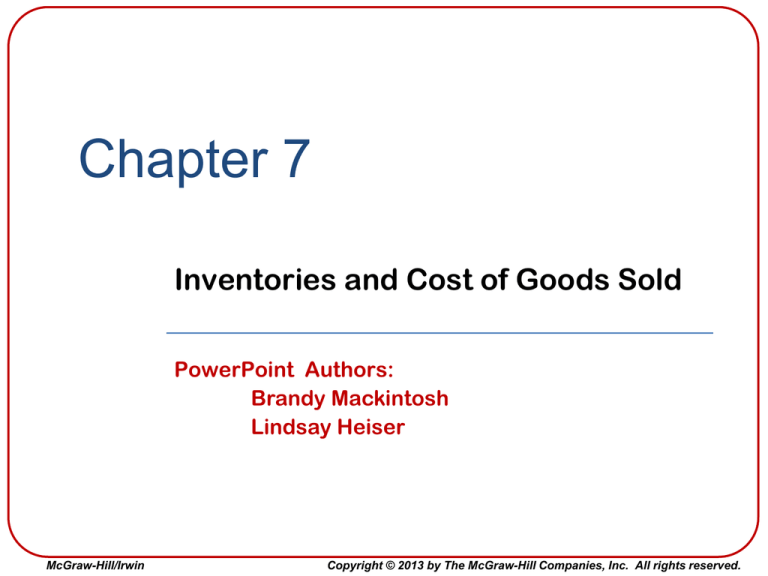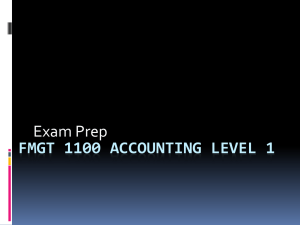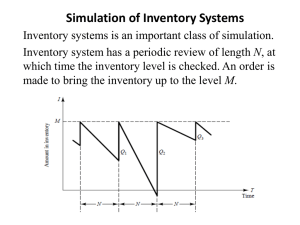
Chapter 7
Inventories and Cost of Goods Sold
PowerPoint Authors:
Brandy Mackintosh
Lindsay Heiser
McGraw-Hill/Irwin
Copyright © 2013 by The McGraw-Hill Companies, Inc. All rights reserved.
Learning Objective 7-1
Describe the issues in
managing different types of
inventory.
7-2
Inventory Management Decisions
The primary goals of inventory managers are to:
1. Maintain a sufficient quantity
to meet customers’ needs
2. Ensure quality meets customers’
expectations and company standards
3. Minimize the costs of acquiring and carrying
the inventory
7-3
Types of Inventory
Merchandisers . . .
Buy finished goods.
Sell finished goods.
Merchandise inventory
Manufacturers . . .
Buy raw materials.
Produce and sell
finished goods.
Raw Materials
Work in Process
Finished goods
Completed products
awaiting sale
Materials waiting to
be processed
Partially
complete products
7-4
Learning Objective 7-2
Explain how to report
Inventory and Cost of Goods
Sold.
7-5
Balance Sheet and Income
Statement Reporting
7-6
Cost of Goods Sold Equation
BI + P – CGS = EI
National Outfitters’ beginning inventory was $4,800. During
the period, the company purchased inventory for $10,200. The
cost of goods sold for the period is $9,000. Compute the
ending inventory.
Cost of Goods Sold Calculation
Beginning Inventory
+ Purchases
= Cost of Goods Available for Sale
- Cost of Goods sold
= Ending Inventory
7-7
$ 4,800
10,200
15,000
9,000
$ 6,000
Cost of Goods Sold Equation
beginning
Inventory
$4,800
+
purchases
$10,000
goods available
for sale
$15,000
7-8
ending
Inventory
$6,000
Cost of
Goods Sold
$9,000
(Balance Sheet)
(Income Statement)
Learning Objective 7-3
Compute costs using four
inventory costing methods.
7-9
Inventory Costing Methods
Specific
identification
First-in, first-out
(FIFO)
Last-in, first-out
(LIFO)
Weighted
average
7-10
Inventory Costing Methods
Consider the following information
May 3
May 5
May 6
May 8
Purchased 1 unit for $70
Purchased 1 more unit for $75
Purchased 1 more unit for $95
Sold 2 units for $125 each
May 6
$95 cost
May 5
$75 cost
May 3
$70 cost
Specific Identification
This method individually identifies and records the cost of
each item sold as part of cost of goods sold. If the items
sold were identified as the ones that cost $70 and $95, the
total cost of those items ($70 + 95 = $165) would be
reported as Cost of Goods Sold. The cost of the remaining
item ($75) would be reported as Inventory on the balance
sheet at the end of the period.
7-11
Inventory Costing Methods
LIFO
May 5
$75 cost
May 5
$75 cost
May 5
$75 cost
May 3
$70 cost
May 3
$70 cost
May 3
$70 cost
Net Sales
Cost of Goods Sold
Gross Profit
$250
145
$105
Balance Sheet
Inventory
$95
Income Statement
Net Sales
Cost of Goods Sold
Gross Profit
$250
170
$ 80
Balance Sheet
Inventory
$70
Still there
May 6
$95 cost
Sold
May 6
$95 cost
Income Statement
7-12
Weighted average
May 6
$95 cost
Still there
Sold
FIFO
$80
$240
= per unit
3
Income Statement
Net Sales
Cost of Goods Sold
Gross Profit
$250
160
$ 90
Balance Sheet
Inventory
$80
Sold
Still
there
Inventory Costing Methods
Summary
FIFO
Cost of Goods sold (Income Statement)
Inventory (Balance sheet)
LIFO
Weighted
Average
Oldest cost Newest cost Average cost
Newest cost Oldest cost Average cost
Let’s consider a more complex example.
Date
Oct 1
Oct 3
Oct 5
Oct 6
7-13
Description
Beginning Inventory
Purchase
Purchase
Sales
Ending Inventory
# of Units
10
30
10
(35)
15
Cost per Unit
$ 7
$ 8
$10
To calculate
To calculate
Total Cost
$
70
240
100
To calculate
To calculate
Inventory Cost Flow Computations
FIFO
+
=
beginning Inventory 10 units
purchases
30 units
10 units
cost of goods available for sale
ending Inventory
Cost of Goods Sold
x
x
x
$ 7
$ 8
$ 10
= $ 70
=
240
=
100
$ 410
140
$ 270
(10 units @ $10) + (5 units @ $8)
(10 units @ $7) + (25 units @ $8)
7-14
Inventory Cost Flow Computations
LIFO
+
=
beginning Inventory 10 units
purchases
30 units
10 units
cost of goods available for sale
ending Inventory
Cost of Goods Sold
x
x
x
$ 7
$ 8
$ 10
= $ 70
=
240
=
100
$ 410
110
$ 300
(10 units @ $7) + (5 units @ $8)
(10 units @ $10) + (25 units @ $8)
7-15
Inventory Cost Flow Computations
Weighted Average
# of
Units
Description
beginning Inventory
purchase
purchase
cost of goods available for sale
Weighted
=
Average Cost
Weighted
=
Average Cost
7-16
Cost
per Unit
10
30
10
50
$ 7
$ 8
$10
Total
Cost
$
70
240
100
$ 410
Cost of goods Available for Sale
Number of Units Available for Sale
$410
50 units
= $8.20 per unit
Inventory Cost Flow Computations
Weighted Average
+
=
Beginning Inventory 10 units
Purchases
30 units
10 units
Cost of Goods Available for Sale
Ending Inventory
Cost of Goods Sold
x
x
x
$ 7
$ 8
$ 10
15 units @ $8.20
35 units @ $8.20
7-17
= $ 70
=
240
=
100
$ 410
123
$ 287
Financial Statement Effects
Effects on the Income Statement
Sales
Cost of Goods Sold
FIFO
$
525
270
Weighted
Average
LIFO
$
525
300
$
525
287
Gross Profit
255
225
238
Operating Expenses
Income from Operations
Other Revenue (Expenses)
125
130
20
125
100
20
125
113
20
Income before Income Tax Expense
Income Tax Expense (30%)
150
45
120
36
133
40
Net Income
$
105
$
84
$
93
$
140
$
110
$
123
Effects on the Balance Sheet
Inventory
7-18
Financial Statement Effects
7-19
Financial Statement Effects
Advantages of Methods
Weighted
Average
First-In,
First-Out
Last-In,
First-Out
Smoothes out
price changes.
Ending inventory
approximates
current
replacement cost.
Better matches
current costs in
cost of goods sold
with revenues.
7-20
Tax Implications and Cash Flow
Effects
Effects on the Income Statement
Sales
Cost of Goods Sold
FIFO
$
525
270
Weighted
Average
LIFO
$
525
300
$
525
287
Gross Profit
255
225
238
Operating Expenses
Income from Operations
Other Revenue (Expenses)
125
130
20
125
100
20
125
113
20
Income before Income Tax Expense
Income Tax Expense (30%)
150
45
120
36
133
40
Net Income
$
105
$
84
$
93
$
140
$
110
$
123
Effects on the Balance Sheet
Inventory
7-21
Learning Objective 7-4
Reporting inventory at the
lower of cost or market.
7-22
Lower of Cost or Market
The value of inventory can fall below its
recorded cost for two reasons:
1. it’s easily replaced by identical goods at a
lower cost, or
2. it’s become outdated or damaged.
When the value of inventory falls below its
recorded cost, the amount recorded for
inventory is written down to its lower
market value. This is known as the lower of
cost or market (LCM) rule.
7-23
Lower of Cost or Market
1,000 items @ $165
Item
Cost
per
Item
Market
Value
per Item
LCM
per
Item
Leather coats
Vintage jeans
$165
20
$150
25
$150
20
1 Analyze
Assets
Inventory
2
1,000
400
1,000 items
@ $150
Liabilities
=
-$15,000
Total
cost
Writedown
$150,000 $165,000
8,000
8,000
$15,000
0
400 items
@ $20
Stockholders’ Equity
+
Cost of Goods
Sold (+E)
-$15,000
Record
dr
7-24
Total Lower
of cost
Quantity or Market
Cost of Goods Sold (+E, -SE)
cr Inventory (-A)
15,000
15,000
Lower of Cost or Market
7-25
Learning Objective 7-5
Analyze and record inventory
purchases, transportation,
returns and allowances, and
discounts.
7-26
Recording Inventory Transactions
We will now look at the accounting for
purchases, transportation costs,
purchase returns and allowances, and
purchase discounts. We will record all
inventory-related transactions in the
Inventory account.
7-27
Inventory Purchases
American Eagle Outfitters purchases
$10,500 of vintage jeans on credit.
1 Analyze
Assets
Inventory (+A)
2
Liabilities
+
Stockholders’ Equity
Accounts
Payable (+L) $10,500
Record
dr
7-28
+$10,500
=
Inventory (+A)
cr Accounts Payable (+L)
10,500
10,500
Transportation Cost
American Eagle pays $400 cash to a trucker who
delivers the $10,500 of vintage jeans to one of its stores.
1 Analyze
Assets
Cash (-A)
Inventory (+A)
2
Liabilities
+
Stockholders’ Equity
-$400
+$400
Record
dr
7-29
=
Inventory (+A)
cr Cash (-A)
400
400
Purchase Returns and
Allowances
American Eagle returned some of the vintage jeans to the
supplier and received a $500 reduction in the balance owed.
1 Analyze
Assets
Inventory (-A)
2
-$500
Accounts
Payable (-L)
+
Stockholders’ Equity
-$500
Record
dr
7-30
Liabilities
=
Accounts Payable (-L)
cr Inventory (-A)
500
500
Purchase Discounts
American Eagle’s vintage jeans purchase for $10,500 had
terms of 2/10, n/30. Recall that American Eagle returned
inventory costing $500 and received a $500 reduction in its
Accounts Payable. American Eagle paid within
the discount period.
1 Analyze
Assets
Cash (-A)
Inventory (-A)
2
-$9,800
-$200
+
Stockholders’ Equity
Accounts
Payable (-L) -10,000
Record
dr
7-31
Liabilities
=
Accounts Payable (-L)
cr Cash (-A)
cr Inventory (-A)
10,000
9,800
200
Summary of Inventory
Transactions
7-32
Learning Objective 7-6
Evaluate inventory
management by computing
and interpreting the inventory
turnover ratio.
7-33
Inventory Turnover Analysis
7-34
Comparison to Benchmarks
7-35
Supplement 7A
FIFO, LIFO, and Weighted Average in
a Perpetual Inventory System
McGraw-Hill/Irwin
Copyright © 2013 by The McGraw-Hill Companies, Inc. All rights reserved.
Perpetual Inventory System
This is the same information that we used earlier in the
chapter to illustrate a periodic inventory system. The only
difference is that we have assumed the sales occurred on
October 4, prior to the final inventory purchase.
Date
Oct 1
Oct 3
Oct 4
Oct 5
7-37
Description
Beginning Inventory
Purchase
Sales
Purchase
Ending Inventory
# of Units
10
30
(35)
10
15
Cost per Unit
Total Cost
$
7 $
70
$
8 $
240
To calculate
To calculate
$
10 $
100
To calculate
To calculate
FIFO (First-in, First-Out)
7-38
LIFO (Last-in, First-Out)
7-39
Weighted Average Cost
$310 ÷ 40 units
= $7.75 per unit
7-40
Financial Statement Effects
Summary of Perpetual Inventory System Cost
Flow Assumptions on Financial Statements
7-41
Supplement 7B
The Effects of Errors in Ending
Inventory
McGraw-Hill/Irwin
Copyright © 2013 by The McGraw-Hill Companies, Inc. All rights reserved.
The Effects of Errors in Ending
Inventory
Cost of Goods Sold Equation
BI + P – CGS = EI
Errors in Ending
Inventory will affect
the Balance Sheet and
the Income Statement.
Assume that Ending Inventory was overstated in 2012 by
$10,000 due to an error that was not discovered until 2013.
2012
7-43
+
-
Beginning Inventory
Purchases
Ending Inventory
Accurate
Accurate
Overstated $10,000
=
Cost of Goods Sold
Understated $10,000
The Effects of Errors in Ending
Inventory
Now let’s examine the effects of the
2012 Ending Inventory Error on 2013.
Assume that Ending Inventory was overstated in 2012 by
$10,000 due to an error that was not discovered until 2013.
2013
7-44
+
-
Beginning Inventory
Purchases
Ending Inventory
Overstated $10,000
Accurate
Accurate
=
Cost of Goods Sold
Overstated $10,000
Supplement 7C
Recording Inventory Transactions in
a Periodic System
McGraw-Hill/Irwin
Copyright © 2013 by The McGraw-Hill Companies, Inc. All rights reserved.
Recording Inventory Transactions
in a Periodic System
A local cell phone dealer stocks and sells one item.
The following events occurred in the past year:
Jan. 1
Apr. 14
Nov. 30
Dec. 31
Beginning inventory: 80 units at a cost of $60.
Purchased 170 additional units on account at a cost of $60.
Sold 150 units on account at a unit sales price of $80.
Counted 100 units at a unit cost of $60.
We will record these events assuming the company uses
a periodic inventory system and then compare the
periodic inventory system to a perpetual inventory system.
7-46
Recording Inventory Transactions
in a Periodic System
Periodic Inventory System
7-47
Perpetual Inventory System
Recording Inventory Transactions
in a Periodic System
Periodic Inventory System
BI + P – CGS = EI
End-of-year adjustment entries are not required using a perpetual inventory system.
7-48
Recording Inventory Transactions
in a Periodic System
Summary of the Effects on the Accounting Equation
Periodic Inventory System
7-49
Perpetual Inventory System
Chapter 7
Solved Exercises
M7-6, M7-7, E7-2, E7-5, E7-10, E7-17
McGraw-Hill/Irwin
Copyright © 2013 by The McGraw-Hill Companies, Inc. All rights reserved.
M7-6 Calculating Cost of Goods Available for Sale, Ending Inventory,
Sales, Cost of Goods Sold, and Gross Profit under Periodic FIFO, LIFO,
and Weighted Average Cost
Given the following information, calculate cost of goods available for sale and
ending inventory, then sales, cost of goods sold, and gross profit, under (a)
FIFO, (b) LIFO, and (c) weighted average. Assume a periodic inventory
system is used.
7-51
M7-6 Calculating Cost of Goods Available for Sale, Ending Inventory,
Sales, Cost of Goods Sold, and Gross Profit under Periodic FIFO, LIFO,
and Weighted Average Cost
a. FIFO
Beginning Inventory
50 units x $10 = $ 500
+ Purchase
250 units x $13 = $3,250
Cost of Goods Available for Sale
$3,750
- Ending Inventory (200 x $13)
= $2,600
= Cost of Goods Sold (50 x $10) + (50 x $13)
$1,150
7-52
M7-6 Calculating Cost of Goods Available for Sale, Ending Inventory,
Sales, Cost of Goods Sold, and Gross Profit under Periodic FIFO, LIFO,
and Weighted Average Cost
b. LIFO
Beginning Inventory
50 units x $10 = $ 500
+ Purchase
250 units x $13 = $3,250
Cost of Goods Available for Sale
$3,750
- Ending Inventory (150 x $13) + (50 x $10)
= $2,450
= Cost of Goods Sold (100 x $13)
$1,300
7-53
M7-6 Calculating Cost of Goods Available for Sale, Ending Inventory,
Sales, Cost of Goods Sold, and Gross Profit under Periodic FIFO, LIFO,
and Weighted Average Cost
c. Weighted Average
Beginning Inventory
50 units x $10 = $ 500
+ Purchase
250 units x $13 = $3,250
Cost of Goods Available for Sale
$3,750
- Ending Inventory (200 x $12.50)
= $2,500
= Cost of Goods Sold (100 x $12.50)
$1,250
Weighted
Average Cost
7-54
=
$3,750
300 units
= $12.50 per unit
M7-6 Calculating Cost of Goods Available for Sale, Ending Inventory,
Sales, Cost of Goods Sold, and Gross Profit under Periodic FIFO, LIFO,
and Weighted Average Cost
Sales (100 units at $15)
Cost of Goods Sold
Gross Profit
7-55
FIFO
$1,500
1,150
$ 350
LIFO
$1,500
1,300
$ 200
Weighted Avg
$1,500
1,250
$ 250
M7-7 Calculating Cost of Goods Available for Sale, Cost of Goods Sold
and Ending Inventory under FIFO, LIFO, and Weighted Average Cost
(Periodic Inventory)
Aircard Corporation tracks the number of units purchased and sold
throughout each accounting period, but applies its inventory costing method
at the end of each period as if it uses a periodic inventory system. Given the
following information, calculate the cost of goods available for sale, ending
inventory, and cost of goods sold, if Aircard uses (a) FIFO, (b) LIFO, or (c)
weighted average cost.
7-56
M7-7 Calculating Cost of Goods Available for Sale, Cost of Goods Sold
and Ending Inventory under FIFO, LIFO, and Weighted Average Cost
(Periodic Inventory)
7-57
Goods Available for Sale – same for all methods
Units
Unit
Cost
Total
Cost
Beginning Inventory
+ Purchase (July 13)
+ Purchase (July 25)
Goods Available for Sale
$ 80,000
264,000
400,000
$744,000
2,000
6,000
8,000
16,000
$40
$44
$50
M7-7 Calculating Cost of Goods Available for Sale, Cost of Goods Sold
and Ending Inventory under FIFO, LIFO, and Weighted Average Cost
(Periodic Inventory)
a. FIFO
Ending Inventory
(7,000 units x $50)
= $350,000
Cost of Goods Sold
(2,000 units x $40)
(6,000 units x $44)
(1,000 units x $50)
= $394,000
b. LIFO
Ending Inventory
Cost of Goods Sold
7-58
(2,000 units x $40)
(5,000 units x $44)
= $300,000
(8,000 units x $50)
(1,000 units x $44)
= $444,000
M7-7 Calculating Cost of Goods Available for Sale, Cost of Goods Sold
and Ending Inventory under FIFO, LIFO, and Weighted Average Cost
(Periodic Inventory)
c. Weighted Average
7-59
Average Unit Cost
$744,000 / 16,000 = $46.50
Ending Inventory
(7,000 units x $46.50)
= $325,500
Cost of Goods Sold
(9,000 units x $46.50)
= $418,500
End of Chapter 7
7-60










